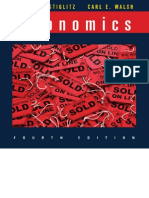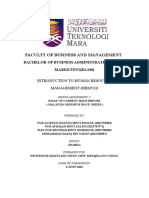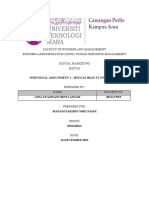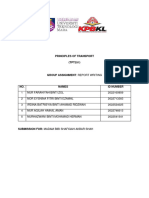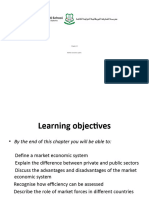Eco120 108 113 107
Eco120 108 113 107
Uploaded by
Amiruddin ZubirCopyright:
Available Formats
Eco120 108 113 107
Eco120 108 113 107
Uploaded by
Amiruddin ZubirOriginal Title
Copyright
Available Formats
Share this document
Did you find this document useful?
Is this content inappropriate?
Copyright:
Available Formats
Eco120 108 113 107
Eco120 108 113 107
Uploaded by
Amiruddin ZubirCopyright:
Available Formats
CONFIDENTIAL
BM/SEP 2011/ECO120/108/113/107
UNIVERSITI TEKNOLOGI MARA FINAL EXAMINATION
COURSE COURSE CODE EXAMINATION TIME
PRINCIPLES OF ECONOMICS EC0120/108/113/107 SEPTEMBER 2011 3 HOURS
INSTRUCTIONS TO CANDIDATES 1. This question paper consists of three (3) parts : PART A (20 Questions) PART B (4 Questions) PART C (4 Questions) Answer ALL questions from PART A and PART B and two (2) questions from PART C. i) ii) Answer PART A in the Objective Answer Sheet. Answer PART B and PART C in the Answer Booklet. Start each answer on a new page.
2.
3.
Do not bring any material into the examination room unless permission is given by the invigilator. Please check to make sure that this examination pack consists of: i) ii) iii) iv) the Question Paper an Answer Booklet - provided by the Faculty an Objective Answer Sheet - provided by the Faculty a graph paper - provided by the Faculty
4.
DO NOT TURN THIS PAGE UNTIL YOU ARE TOLD TO DO SO
This examination paper consists of 11 printed pages
Hak Cipta Universiti Teknologi MARA CONFIDENTIAL
CONFIDENTIAL
BM/SEP 2011/EC0120/108/113/107
PART A
The opportunity cost is best defined as: A. B. C. D. the monetary price of any productive resources. the amount of labour that must be used to produce one unit of any product. the ratio of the prices of imported goods to the prices of exported goods. the amount of one product that must be given up to produce one more unit of another product.
2.
The economic problem of scarcity refers to A. B. C. D. unlimited wants and unlimited resources. limited resources and unlimited wants. limited wants and limited resources. unlimited resources and limited wants.
3.
The increase in demand of a new launched PROTON car can be caused by A. B. C. D. an increase in income. a change in climate. a lower cost of production. an increase in the price of petrol.
The demand curve for rice represents the relationship between the quantity demanded and the A. B. C. D. prices of factors of production. general price level. price of rice. supply of rice.
Market equilibrium is achieved when A. B. C. D. the number of buyers is equal to the number of sellers. the quantity demanded is equal to the quantity supplied. the price is equal to the quantity. the quantity demanded is equal to the number of buyers.
Hak Cipta Universiti Teknologi MARA
CONFIDENTIAL
CONFIDENTIAL
BM/SEP 2011/ECO120/108/113/107
6.
If the value of cross elasticity of demand between good X and good Y is negative, good X and good Y are A. B. C. D. substitute goods. complementary goods. essential goods. inferior goods.
7.
If the elasticity of supply is 0.4, it indicates that supply is A. B. C. D. unitary elastic. elastic. perfectly elastic. inelastic.
8.
Demand for agricultural products is generally A. B. C. D. elastic. unitary elastic. inelastic. perfectly elastic.
9.
Which of the following is not considered to be a fixed input? A. B. C. D. Factory buildings. Offices. Raw materials. Motor vehicles.
10.
The shape of the demand curve for a perfectly competitive firm is A. B. C. D. sloped downwards from left to right. sloped upwards from left to right. perfectly inelastic. perfectly elastic.
11.
These are all macroeconomic objectives except A. B. C. D. to to to to achieve achieve achieve achieve price stability. universal education. economic growth. a healthy balance of payment.
Hak Cipta Universiti Teknologi MARA
CONFIDENTIAL
CONFIDENTIAL
BM/SEP 2011/EC0120/108/113/107
12.
An equitable distribution of income between the rich and the poor can be done through A. B. C. D. a balance of payment. an increase in money supply in the economy. an imposition of tax and subsidy. a decrease in national income.
13.
The total value of goods and services produced by factors of production owned by a country's citizens within the country and abroad is known as A. B. C. D. gross domestic product. disposable income. gross national product. national income.
14.
The main factor that differentiates gross national product from net national product is A. B. C. D. net investment. gross investment. depreciation. net factor income from abroad.
15.
Which of the following steps in a monetary policy can decrease the problem of inflation in an economy? A. B. C. D. Purchase of government securities, decrease reserve ratio and increase interest rate. Sale of government securities, increase reserve ratio and increase interest rate. Sale of government securities, decrease reserve ratio and increase interest rate. Purchase of government securities, increase reserve ratio and increase interest rate.
16.
Contractionary fiscal policy is imposed by the government to A. B. C. D. reduce problems of inflation. reduce problems of unemployment. increase aggregate demand. increase the money supply in the economy.
Hak Cipta Universiti Teknologi MARA
CONFIDENTIAL
CONFIDENTIAL
BM/SEP 2011/EC0120/108/113/107
17.
An increase in the price of raw materials causes A. B. C. D. an import-push inflation. a profit-push inflation. a cost-push inflation. a demand-pull inflation.
18.
The unemployment rate is the A. B. C. D. percentage of the labour force which is out of work. ratio of unemployed to employed worker. percentage of the total population which is out of work. some workers lack marketable job skills.
19.
Which of the following is a reason for protectionism? A. B. C. D. Reducing structural unemployment. Reducing inflation problems. Controlling the money supply in the economy. Protecting infant and local industries.
20.
Which of the following would be an indication that a nation has a balance of payment deficit? A. B. C. D. Buying gold abroad. Borrowing abroad to finance capital investments. Imports exceed exports. Holding of foreign reserve is increasing.
Hak Cipta Universiti Teknologi MARA
CONFIDENTIAL
CONFIDENTIAL
BM/SEP 2011/EC0120/108/113/107
PARTB
QUESTION 1 Imagine that a country can produce just two things: goods and services. Assume that over a given time period it could produce any of the following combinations in the table below. Unit of goods Units of services 79 19 0 80 90 100
10
20
30
40
50
60
70
80
77
74
70
65
58
48
35
a)
Sketch the country's production possibility curve (PPC). (2 marks)
b)
What does the shape of the production possibility curve (PPC) above indicate? (1 mark) Assume that the country is currently producing 40 units of goods and 70 units of services, what is the opportunity cost of producing another 10 units of goods? (1 mark)
c)
d)
Now assume that technical progress leads to an increase in the output of goods for any given amount of resources. Show this effect on the production possibility curve in a diagram. (2 marks) List four (4) assumptions of production possibility curve. (4 marks)
e)
Hak Cipta Universiti Teknologi MARA
CONFIDENTIAL
CONFIDENTIAL
BM/SEP 2011/EC0120/108/113/107
QUESTION 2 The table below shows the weekly market demand and supply of tomatoes in a free market.
Price per kg (RM) 4.00 3.50 3.00 2.50 2.00 1.50 1.00
Quantity demanded (.000 kg) 30 35 40 45 50 55 60
Quantity supplied (,000 kg) 80 68 62 55 50 45 38
a)
Using a graph paper, plot the demand and supply curves for tomatoes based on the data above. (3 marks) Define market equilibrium price. Determine the market equilibrium price and quantity. (3 marks)
b)
c)
Calculate the elasticity of supply when price of tomatoes increase from RM2.50 to RM3.50 per kg. (2 marks) The producers' incomes have increased from RM3000 to RM4000 per month and quantity demanded of tomatoes from 45,000 kg to 55,000 kg. Calculate the income elasticity of demand. (2 marks)
d)
Hak Cipta Universiti Teknologi MARA
CONFIDENTIAL
CONFIDENTIAL
BM/SEP 2011/EC0120/108/113/107
QUESTION 3 The table below shows the cost and revenue for a perfectly competitive firm. The Average Revenue (AR) is fixed at RM12 per unit. Quantity (unit) 0 1 2 3 4 5 6 Total Variable Cost (TVC) Total Cost (TC) 12 22 28 33 40 52 72 Marginal Cost (MC) Total Revenue (TR) Marginal Revenue (MR)
a)
Complete the table above. (4 marks)
b)
Determine the profit maximizing output. (1 mark)
c)
Calculate the amount of profit the firm is earning at equilibrium. State the type of profit. (2 marks) How much is the total fixed cost for the above firm? (1 mark)
d)
e)
At equilibrium, calculate: i) ii) the Average Cost (AC). the Average Variable Cost (AVC). (2 marks)
Hak Cipta Universiti Teknologi MARA
CONFIDENTIAL
CONFIDENTIAL
BM/SEP 2011/EC0120/108/113/107
QUESTION 4 The data below show components of national income for country ABC in the year 2010. Items Agriculture and mining Construction Net factor income from abroad Manufacturing Gas and electricity Banking and finance Government services Wholesales and retails Depreciation Subsidies Indirect taxes a) Calculate: i) ii) iii) b) Gross domestic product at market price. (3 marks) Gross domestic product at factor price. (2 marks) Net national product at factor cost. (3 marks) State whether the following items would be included in the calculation of personal income or national income. i) ii) iii) iv) Social contribution Corporate dividends Contribution to EPF Rental income : : : : . . . . (2 marks)
Hak Cipta Universiti Teknologi MARA CONFIDENTIAL
RM million 10 45 20 50 20 80 30 60 5 10 5
CONFIDENTIAL
10
BM/SEP 2011/EC0120/108/113/107
PARTC
QUESTION 1 a) Explain the difference between change in supply and change in quantity supplied using diagrams. (8 marks) Briefly explain four (4) determinants of price elasticity of demand. (12 marks)
b)
QUESTION 2 a) Using appropriate diagram, elaborate on the three (3) stages of production. (10 marks) b) With the aid of diagrams, briefly explain the followings: i) ii) maximum price. minimum price. (10 marks) QUESTION 3 a) Using diagrams, explain the types of profit a monopolistic firm can earn in the short run. (12 marks) Briefly describe four (4) differences between the characteristics of a monopoly firm and a perfectly competitive firm. (8 marks)
b)
Hak Cipta Universiti Teknologi MARA
CONFIDENTIAL
CONFIDENTIAL
11
BM/SEP 2011/EC0120/108/113/107
QUESTION 4 a) With appropriate examples, briefly explain the following types of unemployment, i) ii) iii) iv) b) Frictional unemployment. Structural unemployment. Cyclical unemployment. Seasonal unemployment. (12 marks) Define national income. Discuss briefly any two (2) uses of national income statistics. (8 marks)
END OF QUESTION PAPER
Hak Cipta Universiti Teknologi MARA
CONFIDENTIAL
You might also like
- Essentials of Development Economics, Third EditionFrom EverandEssentials of Development Economics, Third EditionRating: 5 out of 5 stars5/5 (1)
- PAD120 TEST 1 - May2022Document2 pagesPAD120 TEST 1 - May2022Elizabeth WongNo ratings yet
- Comparative Management Assignment.Document17 pagesComparative Management Assignment.Sajid AfridiNo ratings yet
- Ads653 Case StudyDocument14 pagesAds653 Case StudyAnis NajwaNo ratings yet
- ITT400 - Introduction To Data Communication and Networking: Universiti Teknologi MARADocument3 pagesITT400 - Introduction To Data Communication and Networking: Universiti Teknologi MARALuqman HasifNo ratings yet
- CSC186 Project ProposalDocument3 pagesCSC186 Project ProposalMark RacoonNo ratings yet
- Reading Past Year (Assignment)Document10 pagesReading Past Year (Assignment)Izzah Afiqah0% (1)
- ECO 415 CH 1 IntroDocument22 pagesECO 415 CH 1 IntroMohd ZaidNo ratings yet
- MKT 420 - Marketing TestDocument5 pagesMKT 420 - Marketing TestmrmashaNo ratings yet
- Sta104 Tutorial 1Document3 pagesSta104 Tutorial 1Ahmad Aiman Hakimi bin Mohd Saifoul ZamzuriNo ratings yet
- Pensonic Holdings BHD Fundamental Company Report Including Financial, SWOT, Competitors and Industry AnalysisDocument14 pagesPensonic Holdings BHD Fundamental Company Report Including Financial, SWOT, Competitors and Industry AnalysisWai Min0% (1)
- Identify Two (2) Similarities and Two (2) Differences Shared by Most ASEAN Countries. (25 Marks)Document7 pagesIdentify Two (2) Similarities and Two (2) Differences Shared by Most ASEAN Countries. (25 Marks)Hamierul Mohamad100% (2)
- MGT 361 - International BusinessDocument43 pagesMGT 361 - International BusinessAhmad FaezNo ratings yet
- Chapter 6Document57 pagesChapter 6raiNo ratings yet
- Economics. J. Stiglitz, C. WalshDocument971 pagesEconomics. J. Stiglitz, C. WalshFelix95% (37)
- CH 10Document60 pagesCH 10Mohammed AljabriNo ratings yet
- Pricing Decisions Policies & PracticesDocument7 pagesPricing Decisions Policies & PracticesHarty Robert0% (1)
- Eco120 108Document10 pagesEco120 108Muhammad AmirulNo ratings yet
- Eco211 210 164 219Document10 pagesEco211 210 164 219Ana MuslimahNo ratings yet
- Ent300 Etr300Document10 pagesEnt300 Etr300Shafiq SyafikaNo ratings yet
- Topic 9 Case Study ADM510Document2 pagesTopic 9 Case Study ADM510haha kelakarNo ratings yet
- Malaysian Employment Laws HRM581/582: Course InformationDocument7 pagesMalaysian Employment Laws HRM581/582: Course InformationAziraNo ratings yet
- Pad 270 Assignment Questions & Video Presentations 2020Document4 pagesPad 270 Assignment Questions & Video Presentations 2020Fays IsmailNo ratings yet
- Felda, Felcra Dan RisdaDocument3 pagesFelda, Felcra Dan RisdaasmawiNo ratings yet
- Tutorial 7 Sale of Goods Act 1957Document3 pagesTutorial 7 Sale of Goods Act 1957包子No ratings yet
- MGT361 - Starbucks in Usa (Marketplaces of North America)Document15 pagesMGT361 - Starbucks in Usa (Marketplaces of North America)Nur Syafiqa YasminNo ratings yet
- Pad390 - Notes On Chapter 4Document5 pagesPad390 - Notes On Chapter 4LunaNo ratings yet
- Data Collection and Analysis: The Reason Why People Choose Not To Eat in UitmDocument26 pagesData Collection and Analysis: The Reason Why People Choose Not To Eat in UitmAtia Umie50% (2)
- LCC112 WRITING How To Write An Introductory Paragraph For An ExpositoryDocument26 pagesLCC112 WRITING How To Write An Introductory Paragraph For An ExpositoryErmi SafiyyahNo ratings yet
- Universiti Teknologi Mara Final Examination: Confidential BM/APR 2011/MKT547/546Document3 pagesUniversiti Teknologi Mara Final Examination: Confidential BM/APR 2011/MKT547/546zatieykarimNo ratings yet
- Exercises Elc 270Document3 pagesExercises Elc 270Nurul IzzatulNo ratings yet
- Organisational and Bussines Management AssignmentDocument6 pagesOrganisational and Bussines Management AssignmentY.Nirmala YellamalaiNo ratings yet
- Group Assignment 1 Current Issue ReportDocument6 pagesGroup Assignment 1 Current Issue ReportWAN NUR'MUNIFAH MAHMOODNo ratings yet
- Portfolio Elc270 Assesment 3 Group TaskDocument3 pagesPortfolio Elc270 Assesment 3 Group TaskbidadariinerakaNo ratings yet
- Assignment Pad370 Task 1Document14 pagesAssignment Pad370 Task 1Elyka TaiNo ratings yet
- QUIZ 1 Agr 113 Chapter 1Document1 pageQUIZ 1 Agr 113 Chapter 1Emellda MANo ratings yet
- Elc590 Informative SpeechDocument2 pagesElc590 Informative SpeechmiaadaaNo ratings yet
- HRM533 Assignment 1 (Group 4) PDFDocument12 pagesHRM533 Assignment 1 (Group 4) PDFMUHD MUKHRIZ MD YAZIDNo ratings yet
- OPM549 - Assignment 1 - NUR FATMA SYAZANA MOHD HILMI - 2018808652Document7 pagesOPM549 - Assignment 1 - NUR FATMA SYAZANA MOHD HILMI - 2018808652Nur Fatma Syazana Mohd HilmiNo ratings yet
- Chapter 6 - Public Accountability in MalaysiaDocument26 pagesChapter 6 - Public Accountability in MalaysiaIra NazirahNo ratings yet
- Mkt558 Individual Assignment ReportDocument10 pagesMkt558 Individual Assignment ReportAINA SYAZWANINo ratings yet
- Test1 MKT 646 Nov 2014Document5 pagesTest1 MKT 646 Nov 2014delisyaaamilyNo ratings yet
- BBNG3103Document17 pagesBBNG3103nadiahrashiqahNo ratings yet
- Hrm533 Group Assignment Current Issue March 2023Document15 pagesHrm533 Group Assignment Current Issue March 2023Sybl ZhdiNo ratings yet
- Chapter 1 211Document13 pagesChapter 1 211Nazirul SafwatNo ratings yet
- Final Exam Sta104 July 2022Document6 pagesFinal Exam Sta104 July 2022Farah FarzanaNo ratings yet
- TPT251 - Principles of TransportDocument25 pagesTPT251 - Principles of TransporteysNo ratings yet
- MKT 420 - Marketing 4PDocument12 pagesMKT 420 - Marketing 4PAmalina AzriNo ratings yet
- MKT243Document11 pagesMKT243mustard100% (1)
- Elc231 QP MT Set 1Document6 pagesElc231 QP MT Set 1zaydaisyah04No ratings yet
- Acc407 Test 1 Q Mar-Aug 2023Document7 pagesAcc407 Test 1 Q Mar-Aug 20232023409784No ratings yet
- Human Resource Management (MGT 340) : Group Assignment (10%)Document2 pagesHuman Resource Management (MGT 340) : Group Assignment (10%)flower boomNo ratings yet
- MGT420Document3 pagesMGT420Ummu Sarafilza ZamriNo ratings yet
- ICT501 Group3 Final ReportDocument69 pagesICT501 Group3 Final ReportMUHAMMAD AKMAL MOHD ZAHARNo ratings yet
- Ent300 Financial PlanDocument32 pagesEnt300 Financial Planakaunsimpan123No ratings yet
- PAD363 C1 - Overview of Industrial Relations - Updated Oct 2021Document18 pagesPAD363 C1 - Overview of Industrial Relations - Updated Oct 2021izyan100% (1)
- Acc406 - Acc07 Test 2 QS Feb 2022Document6 pagesAcc406 - Acc07 Test 2 QS Feb 2022Assignments HelperNo ratings yet
- Management 111204015409 Phpapp01Document12 pagesManagement 111204015409 Phpapp01syidaluvanimeNo ratings yet
- Eco - 162 - Teaching - Materials - Topic 1 - 3Document53 pagesEco - 162 - Teaching - Materials - Topic 1 - 3Atiqah RazakNo ratings yet
- Ads408 Introduction To Malaysian Premiership Studies CoDocument3 pagesAds408 Introduction To Malaysian Premiership Studies Couitm.mizudinNo ratings yet
- HRM 659 - CHP 5Document12 pagesHRM 659 - CHP 5Amrezaa Iskandar100% (1)
- ECO120 Apr 2009Document12 pagesECO120 Apr 2009Azie MahmoodNo ratings yet
- Eco211 210 164 219Document10 pagesEco211 210 164 219RazakSengkoNo ratings yet
- Final Exam Eco Sem 2 2010Document10 pagesFinal Exam Eco Sem 2 2010Syazmir ShamsuddinNo ratings yet
- Written Assignment 1Document4 pagesWritten Assignment 1ahmed almhjaniNo ratings yet
- Economics PDFDocument38 pagesEconomics PDFUtkarsh TiwariNo ratings yet
- Course Pocket 5Document33 pagesCourse Pocket 5Aaron Christopher SungaNo ratings yet
- Supply Chain Inventory Production Planning Exam Prep OralDocument53 pagesSupply Chain Inventory Production Planning Exam Prep OralCorinaCiobanuNo ratings yet
- Daniel Ahn Speculation Commodity PricesDocument29 pagesDaniel Ahn Speculation Commodity PricesDan DickerNo ratings yet
- Determination of Basic Household Water RequirementsDocument59 pagesDetermination of Basic Household Water RequirementsWing MacNo ratings yet
- European Journal of Operational Research: Jozsef VorosDocument9 pagesEuropean Journal of Operational Research: Jozsef VorosDina SelimiNo ratings yet
- Practice Set - PGDM HRDocument7 pagesPractice Set - PGDM HRDaksh AnejaNo ratings yet
- ANA Demand Generation PlaybookDocument33 pagesANA Demand Generation PlaybookDemand Metric100% (1)
- 4.91 Master of Management Systme MMS Sem I and II PDFDocument93 pages4.91 Master of Management Systme MMS Sem I and II PDFPrasad NaikNo ratings yet
- Liquidity Preference Theory of InterestDocument3 pagesLiquidity Preference Theory of InterestKavyanjali SinghNo ratings yet
- Unit 2 3 - Lesson 8 - Calculating Market EquilibriumDocument7 pagesUnit 2 3 - Lesson 8 - Calculating Market Equilibriumapi-260512563No ratings yet
- Sample ResearchDocument19 pagesSample Researchmolavejanine2No ratings yet
- Fims Unit - 1Document17 pagesFims Unit - 1arjunmba119624No ratings yet
- Buckley P Casson M 1998 Analyzing Foreign Market Entry StrategiesDocument24 pagesBuckley P Casson M 1998 Analyzing Foreign Market Entry StrategiesMaría De Los ÁngelesNo ratings yet
- Materi Manajemen Persediaan Manlog PDFDocument16 pagesMateri Manajemen Persediaan Manlog PDFdillaelfaziaNo ratings yet
- Seismic Fragility of Transportation Lifeline Piers in The Philippines, Under Confinement and Shear Failure.Document20 pagesSeismic Fragility of Transportation Lifeline Piers in The Philippines, Under Confinement and Shear Failure.Michael Bautista BaylonNo ratings yet
- Chapter 13 IGCSEDocument80 pagesChapter 13 IGCSEtaj qaiserNo ratings yet
- Exam Energy MarketDocument11 pagesExam Energy Marketcormando1992No ratings yet
- Lot Size Planning in IBPDocument6 pagesLot Size Planning in IBPSatyabrata NathNo ratings yet
- Customer Influence On Inflation and Deflation - PDF - 20240923 - 204152 - 0000Document10 pagesCustomer Influence On Inflation and Deflation - PDF - 20240923 - 204152 - 0000Koushik Guru GNo ratings yet
- Final Business Plan For A Furniture ShopDocument30 pagesFinal Business Plan For A Furniture ShopTom JogooNo ratings yet
- Economics Factors Affecting Demand and SupplyDocument16 pagesEconomics Factors Affecting Demand and SupplyVaibhav P. BhagwatNo ratings yet
- Exam 3890Document36 pagesExam 3890Tauseef AhmedNo ratings yet
- TOEIC-style Error Recognition: 23130 Page 1 of 2Document2 pagesTOEIC-style Error Recognition: 23130 Page 1 of 2Jessie Radaza TutorNo ratings yet
- Marketing Important 2 Mark Questions - KTDocument20 pagesMarketing Important 2 Mark Questions - KTjasminakalathil6No ratings yet














